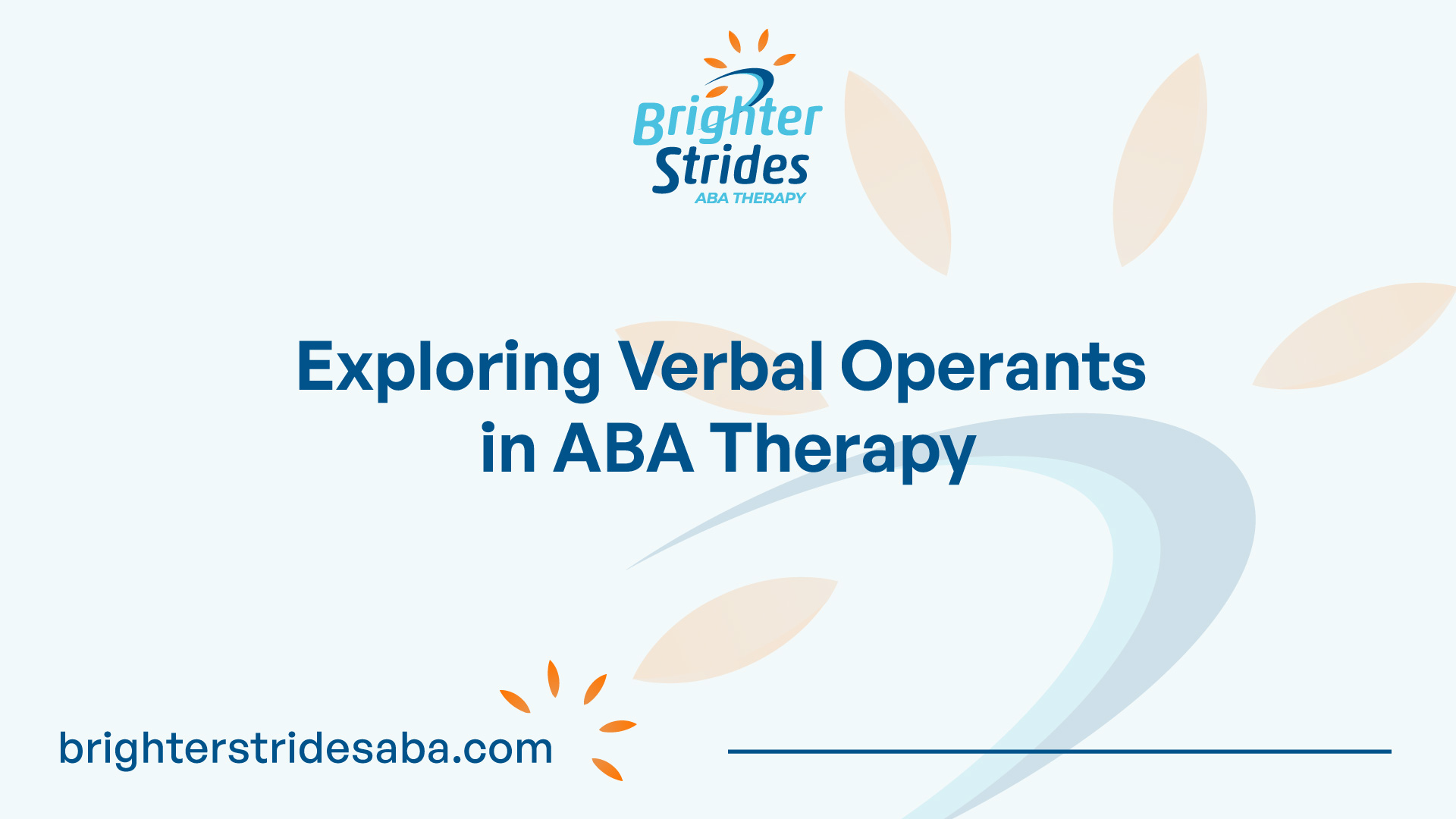Understanding Verbal Operants
Verbal operants play a crucial role in Applied Behavior Analysis (ABA) therapy, contributing to the development of language and communication skills. By understanding the basics of verbal operants and their importance in communication development, therapists can effectively guide individuals towards improved communication abilities.

Basics of Verbal Operants
Verbal behavior encompasses various operants, each serving a unique function in communication. Some of the key verbal operants include:
- Mand: The mand operant involves making requests or asking for something. For example, asking for a ball or requesting a drink. Mands are essential for individuals to express their needs and wants effectively.
- Tact: The tact operant involves labeling or expressing observations about the environment. It is the ability to identify and describe objects, actions, or events. For instance, labeling a dog or describing the color of a flower.
- Echoic: The echoic operant involves repeating or imitating what is heard. This operant helps individuals develop auditory discrimination skills and learn to vocalize words or phrases after hearing them.
- Intraverbal: The intraverbal operant involves responding conversationally or answering questions. It allows individuals to engage in back-and-forth communication, such as responding appropriately to questions or engaging in a conversation on a specific topic.
- Listener Responding: The listener responding operant involves following directions or responding to requests from others. It is the ability to comprehend and execute instructions given by others.
- Motor Imitation: The motor imitation operant involves copying or imitating movements. This operant helps individuals learn motor skills by replicating the actions they observe.
- Visual Perception Match-to-Sample: The visual perception match-to-sample operant involves sorting and matching like items based on visual cues. It helps individuals develop visual discrimination skills and identify similarities and differences between objects.
Importance in Communication Development
Verbal operants are fundamental in communication development as they form the building blocks for language acquisition and expressive abilities. By teaching and reinforcing skills within each verbal operant, therapists can promote growth in overall communication skills.
Learning skills within one verbal operant often leads to growth in other operants. For example, as an individual becomes proficient in manding, they may also improve their ability to tact, echoic, and engage in intraverbal communication. This interconnectedness between verbal operants allows for remarkable growth in clients’ overall skills.
By focusing on teaching and reinforcing verbal operants, therapists can expand clients’ skill repertoire, facilitating their progress in communication and language development. As individuals gain proficiency in each operant, they become better equipped to learn more complex skills, enhancing their overall communication abilities.
Types of Verbal Operants
Verbal operants play a crucial role in the field of Applied Behavior Analysis (ABA) and are fundamental in assessing and developing language skills within an ABA program. Let’s explore the six main types of verbal operants: mand, tact, echoic, intraverbal, listener responding, and motor imitation.
Mand, Tact, and Echoic
The mand is the first verbal operant acquired by a child and serves as a request for something they want or need. According to Cooper, Heron & Howard (2007), learning to mand for an item can decrease undesired behaviors associated with acquiring that item [2]. Mands occur when there is a motivating operation for something, with the reinforcement being the acquisition of that thing directly related to the motivating operation.
The tact involves labeling or identifying objects, actions, or events in the environment. It is the verbal operant responsible for expanding vocabulary and developing expressive language skills. By teaching individuals to tact items, they learn to associate words with their corresponding meanings.
Echoic behavior involves the repetition or imitation of speech sounds or words. It serves as a precursor to other verbal operants such as tacts and mands. Echoic training helps individuals develop auditory discrimination skills and reinforces their ability to imitate verbal behavior.
Intraverbal, Listener Responding, and Motor Imitation
Intraverbal behavior refers to responding to verbal statements or questions. It involves engaging in conversations, answering questions, and filling in missing words or phrases. Intraverbal training helps individuals develop conversational skills, understand social cues, and express thoughts and ideas.
Listener responding focuses on understanding and responding to spoken language. It involves following instructions, answering questions, and demonstrating comprehension of verbal stimuli. By mastering listener responding skills, individuals improve their receptive language abilities and demonstrate understanding of various forms of communication.
Motor imitation involves copying or imitating actions without explicit instructions. It plays a vital role in developing both verbal and non-verbal communication skills. By imitating movements and actions, individuals learn to understand and replicate gestures, signs, and other physical behaviors.
Understanding the different types of verbal operants is essential in ABA therapy as they form the building blocks for assessing and developing language skills. A comprehensive ABA program incorporates strategies to target each of these operants, enabling individuals to enhance their communication abilities and foster growth in language development.
Significance in ABA Therapy
Verbal operants play a significant role in Applied Behavior Analysis (ABA) therapy, particularly in the development of language and communication skills. Understanding the importance of verbal operants is essential for professionals working with individuals with communication challenges. Let’s explore their role in language development and their significance as building blocks for communication skills.
Role in Language Development
Verbal operants are foundational in developing language and communication skills, as they form the basis for effective communication. Learning skills within one verbal operant can promote growth in other verbal operants, creating a strong foundation for language development. This is crucial for individuals with communication challenges, as it enables them to express themselves, comprehend others, and engage in meaningful interactions.
Within the field of ABA, verbal operants such as “mand,” “tact,” and “intraverbal” are considered fundamental building blocks of language [5]. Each of these operants serves a specific function in language development. For instance, the “mand” operant focuses on requesting or expressing needs, while the “tact” operant involves labeling or describing objects or events. The “intraverbal” operant relates to conversational skills and responding to questions or comments.
By teaching and reinforcing these verbal operants, individuals with communication challenges can acquire the necessary skills to effectively express themselves, comprehend others, and engage in meaningful interactions. This lays the groundwork for further language development and paves the way for acquiring more complex communication skills.
Building Blocks for Communication Skills
Verbal operants are critical building blocks within any ABA program designed to assess and develop language skills. They serve as functional units of language, allowing individuals to effectively express themselves, comprehend others, and engage in meaningful interactions. B.F. Skinner, a renowned psychologist and behavior analyst, categorized verbal operants as essential components for teaching individuals with communication challenges within the framework of ABA.
Teaching verbal operants is crucial for expanding clients’ skill repertoire and promoting growth in communication and language development [4]. As individuals gain proficiency in each operant, they become better equipped to learn more complex skills. By mastering foundational verbal operants, individuals can build upon their abilities and develop a wide range of communication skills.
The development of functional language skills through the acquisition of verbal operants is vital for individuals with communication challenges. It empowers them to connect with others, express themselves, and thrive in interactions with the world. Enhancing their quality of life, functional language skills enable individuals to navigate the social and academic domains more effectively.
Through ABA therapy, individuals with communication challenges can strengthen their verbal operants, acquiring the necessary tools to communicate their needs, engage in conversations, and develop meaningful connections with others. By focusing on these foundational aspects of language, ABA professionals can make a profound impact on improving communication skills and overall quality of life for their clients.
Teaching Verbal Operants
When it comes to teaching verbal operants in ABA therapy, employing effective strategies is key to promoting growth in communication and language development. Verbal operants play a crucial role in expanding clients’ skill repertoire, enabling the teaching of more complex skills as clients gain proficiency in each operant. In this section, we will explore strategies for effective teaching of verbal operants, including individualized instruction and prompting techniques.
Strategies for Effective Teaching
To effectively teach verbal operants, it is essential to tailor teaching strategies to align with each individual’s specific needs. This approach is known as individualized instruction. By understanding the unique strengths, challenges, and learning styles of each learner, ABA practitioners can design personalized interventions that maximize progress.
Individualized instruction involves breaking down the target skills into smaller, manageable steps. This allows learners to build their competencies gradually and experience success at each stage. ABA practitioners can use various teaching methods, such as discrete trial training (DTT), natural environment teaching (NET), or a combination of both, based on the learner’s needs and preferences.
In addition to individualized instruction, positive reinforcement plays a crucial role in teaching verbal operants. By providing praise, tokens, or other preferred rewards, learners are motivated to engage in the desired communication behaviors. Reinforcement should be contingent upon the correct response or approximation of the target skill, reinforcing the learner’s progress and increasing the likelihood of future successful responses.
Individualized Instruction and Prompting Techniques
Prompting techniques are another valuable tool for teaching verbal operants. Prompting involves providing cues or guidance to help learners produce the desired response. The level of prompting used depends on the learner’s current skill level and the specific operant being targeted.
Some common prompting techniques in ABA therapy include:
- Physical Prompting: Physically guiding the learner’s hand or body to produce the correct response. This technique is gradually faded as the learner becomes more independent.
- Visual Prompting: Using visual aids, such as pictures, gestures, or written prompts, to support the learner’s understanding of the desired response.
- Verbal Prompting: Providing verbal cues or hints to guide the learner towards the correct response. Verbal prompts can be gradually faded as the learner gains proficiency.
- Modeling: Demonstrating the desired response for the learner to imitate. This technique can be particularly effective for teaching echoic or imitative operants.
The selection and implementation of prompting techniques should be based on the learner’s individual needs and the specific operant being targeted. It is essential to monitor the learner’s progress closely and adjust the level and type of prompting as needed to promote independence and mastery of the target verbal operants.
By utilizing strategies for effective teaching, such as individualized instruction and prompting techniques, ABA practitioners can empower learners to develop their communication skills and make meaningful progress in their verbal operants. These strategies help lay a solid foundation for language development and pave the way for enhanced communication abilities in individuals with communication challenges.
Practical Applications
Verbal operants play a crucial role in the field of Applied Behavior Analysis (ABA) and have practical applications for enhancing communication skills and promoting growth in language development.
Enhancing Communication Skills
Verbal operants are foundational in developing language and communication skills, with learning skills within one verbal operant promoting growth in other verbal operants. By teaching individuals with communication challenges the various verbal operants, they can develop the ability to connect and express themselves effectively.
One practical application of verbal operants is the teaching of the “mand” operant. The “mand” operant involves requesting or demanding something. By teaching individuals to use requests in a functional and appropriate manner, their communication skills are enhanced. This allows them to express their needs, wants, and preferences, leading to more successful interactions and increased independence.
Another practical application is the teaching of the “tact” operant. The “tact” operant involves labeling or describing objects, events, or experiences. By teaching individuals to tact items in their environment, they can expand their vocabulary, develop a better understanding of their surroundings, and effectively communicate with others.
Promoting Growth in Language Development
The use of verbal operants in ABA therapy promotes growth in language development. As individuals gain proficiency in each operant, their skill repertoire expands, enabling the teaching of more complex skills. This progression allows individuals to develop a broader range of language abilities and engage in meaningful conversations.
Verbal operants provide a framework for teaching receptive language skills, also known as “listener responding.” This involves teaching individuals to follow instructions, answer questions, and demonstrate comprehension of spoken language. By targeting listener responding skills, individuals can enhance their ability to understand and process information, improving their overall communication abilities.
Additionally, the “intraverbal” operant plays a vital role in promoting growth in language development. This operant involves responding to verbal stimuli with appropriate verbal responses that are not directly related to the stimuli. Teaching individuals to engage in meaningful conversations, respond to questions, and initiate dialogue allows them to develop more advanced language skills and engage in social interactions.
By utilizing verbal operants in ABA therapy, individuals with communication challenges can develop functional language skills, connect with others, and thrive in their interactions with the world. The practical applications of verbal operants empower individuals to express themselves effectively, enhancing their quality of life and promoting overall growth in language development.
Research Insights
In the field of Applied Behavior Analysis (ABA) therapy, understanding the underlying mechanisms of verbal operants is crucial for effective intervention strategies. Ongoing research provides valuable insights into the memory patterns and molecular mechanisms involved in transcription, shedding light on the complexities of verbal operants in ABA therapy.
Memory Patterns in Transcription
Research has shown that plants exposed to dehydration stress exhibit memory patterns in transcription. Following initial exposure to stress, certain genes return to their pre-stressed transcript levels during the watered recovery phase. Surprisingly, these genes do not respond further to subsequent stresses of similar magnitude and duration. This transcriptional behavior is referred to as the “revised-response” memory genes.
The memory response pattern displayed by the revised-response memory genes is rather unusual. Despite initially robustly responding to the first stress, these genes do not maintain an elevated transcriptional activity during subsequent exposures. Instead, they exhibit a return to their pre-stressed transcript levels, resulting in a lack of response to subsequent similar stresses.
Molecular Mechanisms and Transcription Memory
Several molecular mechanisms have been identified as potential regulators of transcription memory. Abscisic acid (ABA), a plant hormone involved in stress responses, along with transcription factors (TFs) from the ABA signaling pathways (ABF2/3/4 and MYC2), and histone modifications (H3K4me3 and H3K27me3) have been implicated in regulating the revised-response transcription memory patterns.
- ABA: The ABA-dependent TFs ABRE1/ABRE2/ABF3 were found not to be essential for the induction of the revised-response memory genes or their memory behavior.
- Transcription Factors: MYC2, a TF involved in ABA-dependent responses, was identified as a critical component for the memory behavior of a specific subset of MYC2-dependent genes.
- Histone Modifications: H3K4me3 and H3K27me3, two types of histone modifications, have been studied in relation to transcription memory. The levels of H3K4me3 correlate with the transcriptional activity of certain genes, while H3K27me3-modified nucleosomes do not prevent efficient transcription.
These research insights provide a deeper understanding of the molecular mechanisms underlying transcription memory and its role in the regulation of revised-response memory genes. Further exploration of these mechanisms can contribute to the development of more targeted and effective interventions in ABA therapy.
In summary, ongoing research in the field of ABA therapy continues to unravel the complexities of verbal operants. The investigation of memory patterns and molecular mechanisms involved in transcription provides valuable insights into the intricacies of verbal behavior and its application in clinical settings.
References
- http://cornerstoneautismcenter.com/aba-therapy/verbal-operants/
- https://www.abaconnect.com/aba-terms/echoics-mands-tacts/
- https://howtoaba.com/verbal-operants/
- https://cornerstoneautismcenter.com/
- https://howtoaba.com/
- https://learningbehavioranalysis.com/b-14-verbal-operants/
- https://cornerstoneautismcenter.com
- https://howtoaba.com
- https://www.ncbi.nlm.nih.gov/pmc/articles/PMC4027201/

 We've just released an article!
Check out our blog!
We've just released an article!
Check out our blog!



